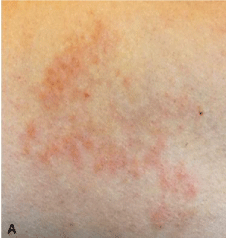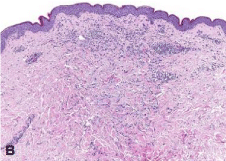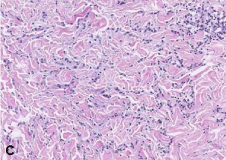Clinical Image
Granuloma Annulare, Drug-Induced Lupus and Certolizumab-Pegol Therapy
Popp F1*, Fischer S2, Kempf W3, Kempis J1, Welcker M4 and Mueller RB1
1Department of Rheumatology, Kantonsspital St. Gallen, Switzerland
2Department of Anesthesiology, Spital Schwyz, Switzerland
3Kempf und Pfaltz, Histologische Diagnostik AG, Zürich, Switzerland
4MVZ für Rheumatologie, Planegg, Germany
*Corresponding author: Florian Popp, Department of Rheumatology, Kantonsspital St. Gallen, Rorschacherstrasse 95, 9007 St. Gallen, Switzerland
Published: 14 Apr, 2017
Cite this article as: Popp F, Fischer S, Kempf W, Kempis
J, Welcker M, Mueller RB. Granuloma
Annulare, Drug-Induced Lupus and
Certolizumab-Pegol therapy. Ann Clin
Case Rep. 2017; 2: 1338.
Clinical Image
A 28-year-old female patient with Crohn’s disease presented with progressive arthralgia, morning
stiffness and a rash on her upper limbs. Symptoms developed insidiously during certolizumab-pegol
(CZP) therapy. In parallel an increase of ANA developed (homogeneous, 1:320). ENA-screening,
including histone antibodies, was negative. Histopathologically a granuloma annulare (GA) was
diagnosed and in summary, diagnosis of a drug-induced lupus (DIL) was clinically established.
Treatment cessation with CZP resulted in regression of these symptoms (Figure 1-3).
DIL is a typical adverse event of TNF-antagonists [1,2]. Appearance of GA as a symptom during
TNF-antagonists therapy is rare and only in case reports documented [3-5]. No case of GA was
described to our knowledge neither secondary to CZP therapy nor in association with DIL.
Occurrence of GA during TNF-antagonists therapy should be considered for new unclear skin
manifestations. A routine clinical examination including ANA-titer measurement is recommended
during TNF-antagonists therapy.
Figure 1
Figure 2
Figure 3
Figure 3
Interstitial component with mainly histiocystes, perivascular
component with mainly lymphocytes (H and E, Original magnification ×200).
References
- De Rycke L, Kruithof E, Van Damme N, Hoffman IE, Van den Bossche N, Van den Bosch F, et al. Antinuclear antibodies following infliximab treatment in patients with rheumatoid arthritis or spondylarthropathy. Arthritis Rheum. 2003;48(4):1015-23.
- Shakoor N, Michalska M, Harris CA, Block JA. Drug-induced systemic lupus erythematosus associated with etanercept therapy. Lancet. 2002; 359(9306):579–80.
- Ratnarathorn M, Raychaudhuri SP, Naguwa S. Disseminated granuloma annulare: a cutaneous adverse effect of anti-tnf agents. Indian J Dermatol. 2011;56(6):752-4.
- Toussirot É, Aubin F. Paradoxical reactions under TNF-α blocking agents and other biological agents given for chronic immune-mediated diseases: an analytical and comprehensive overview. RMD Open. 2016; 15;2(2):e000239.
- Voulgari PV, Markatseli TE, Exarchou SA, Zioga A, Drosos AA. Granuloma annulare induced by anti-tumour necrosis factor therapy. Ann Rheum Dis. 2008;67(4):567-70.



